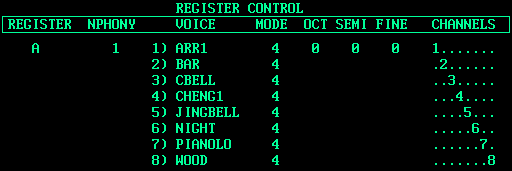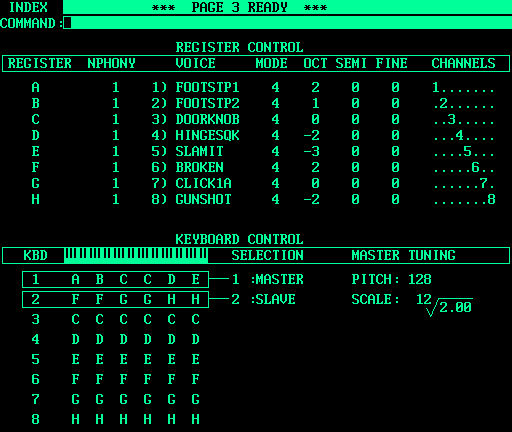
| Home | Web Design | Programming | Fairlight CMI | Soap Box | Downloads | Links | Biography | About... | Site Map |
 |
FAIRLIGHT CMI PAGE 3 |
| Fairlight CMI |
Examples | Swap Shop | Messageboard | Tales | Images | Wild | Technology | Voicetracker |
News Flash |
· GH Services is the North American distributor for BassLab of Germany.
Click here
for these unique guitars and basses. · Horizontal Productions repairs and upgrades Fairlight CMIs from Series I to MFX2. Visit http://www.horizontal.co.uk/. |
|
FAIRLIGHT CMI |
Each audio card has its own balanced output on the back panel of the
CMI. Page 3 shows which voice (sound) is coming out of each of the
outputs. |

|
This image shows a typical arrangement with multiple voices loaded, perhaps
in preparation for a Page R session. Each voice can be transposed up or down by octaves, semitones, and 1/100ths of a semitone to bring all of the sounds to the same reference pitch. Also, the Master Tuning control can be used to adjust all voices up or down as much as 1/4 tone in 256 steps. The common Western tuning of 12th root of 2 (where the pitch doubles every 12 notes) can be changed to any other scale. For example, the quarter-tone scale can created by changing to the 24th root of 2 (pitch doubles every 24 notes). A "stretched" tuning, like on a piano, can be simulated with the 24th root of 4.01. Registers are logical groupings of one or more audio output channels. The nphony indicates how many channels are dedicated to each register. Up to 8 registers can exist, as long as the total nphony does not exceed 8. If several channels are allocated to a register (by setting the nphony > 1), the total number of registers is reduced accordingly. The following image shows a simple Jazz rhythm section. |

|
Register A uses four channels for the PIANO voice, which allows four
simultaneous notes to be played with that voice. The remaining channels
are allocated to four other sounds. The default configuration allocates all eight channels to one register. This would typically be used for a live performance. |

|
The other extreme is illustrated in the following image, where all of
the channels are dedicated to one register with an nphony of 1.
After eight different voices are multi-loaded on
Page 2, they all play simultaneously when one
key is pressed. A more realistic application of this is to create phasing,
flanging, or chorusing by loading two (or more) slightly different versions
of the same sound. |

|
A problem with this setup is that each voice cannot be individually
transposed, which is sometimes necessary to play all sounds in tune. The bottom half of Page 3 is dominated by the Keyboard Control section. The Fairlight CMI maintains eight virtual keyboard layouts, which are mappings of registers to octaves. The physical keyboard can be set to any one of the virtual keyboards. This arrangement of virtual and physical keyboards allows for the rapid changing of sounds during a live situation. This overcomes the slowness of the floppy drives. In use, the sounds for an entire song would be loaded before the performance, and then the virtual keyboard would be selected rapidly during the performance with the Kn command. Some CMIs have an optional slave keyboard, which makes this process even easier. When creating sound effects for film or television, it is useful to map eight different sounds to various regions of the virtual keyboards, as the following image shows. |

|
Some voices are transposed to keep them in a normal range while allowing
them to be triggered from the extreme ends of the physical keyboards. Sound
effects typically sound "real" only if played within a few semitones of
their original pitch, so it is all right to dedicate only an octave or two
of virtual keyboard space to each voice. Using both physical keyboards, a
Foley artist can "play" the sound effects in sync with the images. All of the settings on Page 3 can be saved into an instrument file (which has a suffix of .IN). Loading the file restores all registers, voices, keyboard layouts, and tunings. Previous page - Page 2: Disk Control Next page - Page 4: Harmonic Profiles |
| Home | Web Design | Programming | Fairlight CMI | Soap Box | Downloads | Links | Biography | About... | Site Map |
| Send comments about this site to Greg at
ghservices.com@gmail.com All trademarks contained herein are the property of their respective owners All pages copyright © 1996-2008 GH Services™ Created 1997-11-28 Last updated 1999-09-30 |